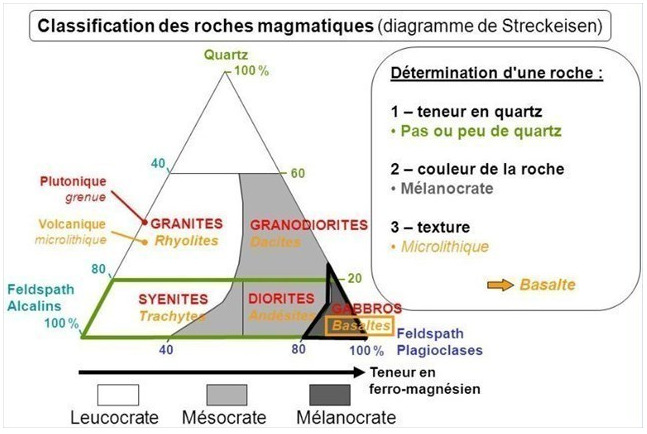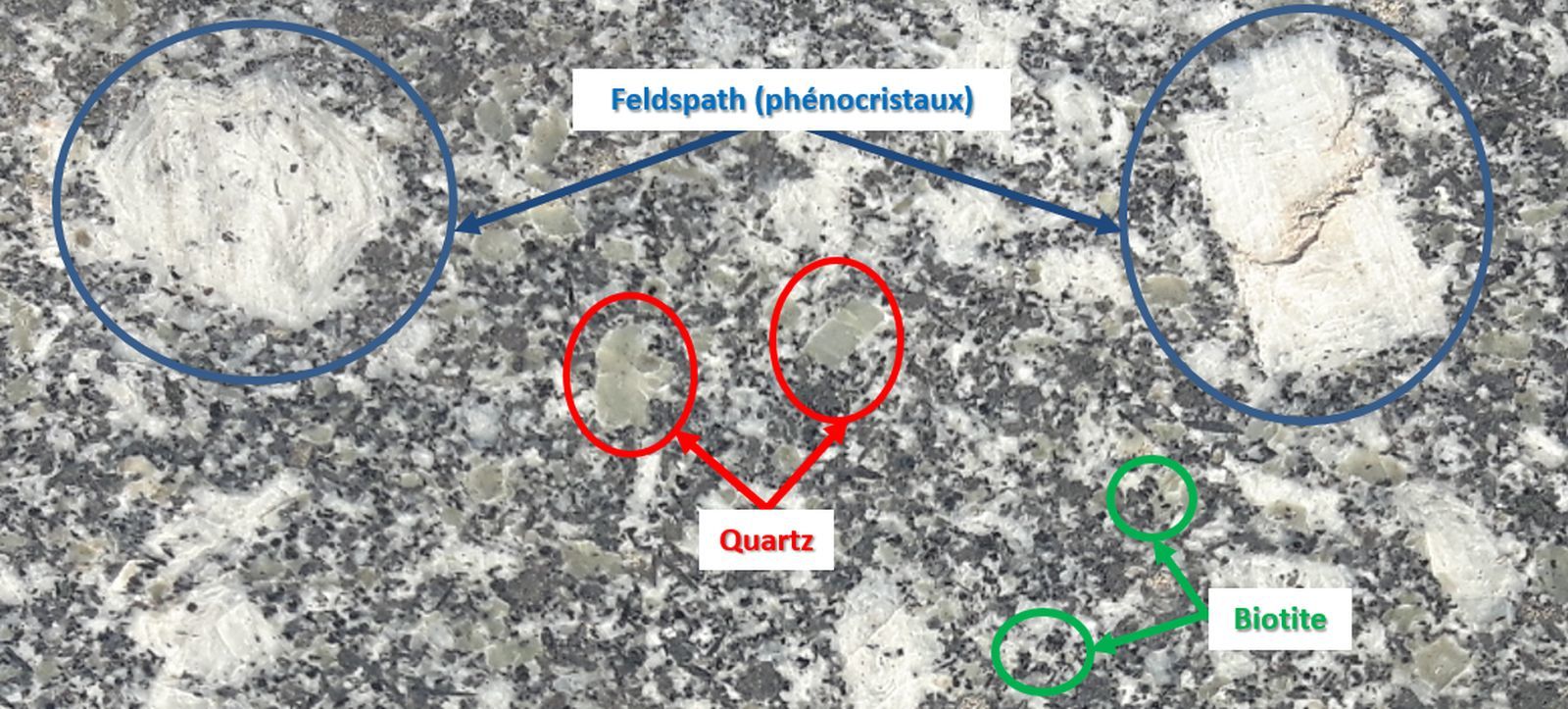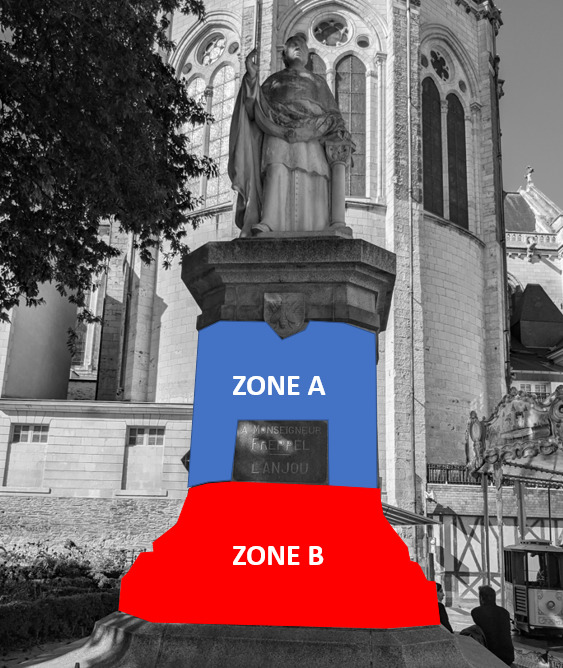
La Earthcache / The Earthcache
Les roches plutoniques sont une sous-famille des roches magmatiques principalement issues de la cristallisation en profondeur d'un magma d'origine mantellique.
Cette origine chimique (magma acide) et les conditions de cristallisation plutôt lente en sont les deux points communs, mais il existe en fait une importante variété de roches plutoniques.
► La composition chimique et minérale
Toutes les roches plutoniques sont des roches cristalline (et non cimentées comme les roches sédimentaires) présentant principalement des minéraux "QFM" :
- Q comme Quartz : translucide parfois transparent, ce minéral est gris sans facette.
- F comme Feldspath : ce minéral opaque avec facettes miroitantes a deux formes :
- une forme potassique (K+), orthose blanche ou rose selon la présence d’oxydes de fer.
- une forme sodique (Na+), albite blanc laiteux et d'aspect brillant, appelé aussi plagioclase.
- M comme Mica : ce minéral se présente en fines paillettes brillantes selon deux formes :
- la biotite, mica noir brillant de composition ferro-magnésienne.
- la muscovite, mica blanc brillant au soleil avec un aspect nacré.

La proportion des minéraux de "Quartz/Feldspath potassique/Feldspath plagioclase" caractérise la nature d'une roche plutonique selon le diagramme de Streckeisen.

La coloration rose d'une roche plutonique, que cela soit au niveau d'un cristal (cas de l'orthose) ou de l'ensemble de la roche, s'explique par la présence d'oxydes de fer (hématite) dans le réseau cristallin.
► Une texture grenue
Ce qui différencie les roches plutoniques des roches volcaniques (ayant la même origine chimique), c'est la présence de cristaux visibles. On parle alors de structure grenue.
La taille de ces grains est directement liée à la vitesse de cristallisation : plus les cristaux sont gros, plus la vitesse de cristallisation est lente.
Dans le cas les plus extrêmes, les plus gros cristaux, généralement des cristaux rectangulaires translucides de feldspaths alcalins, dépassent un centimètre de long et sont appelés des phénocristaux.
On parle alors de granite à texture porphyroïde.

Plutonic rocks are a sub-family of magmatic rocks mainly resulting from the deep crystallization of a magma of mantle origin.
This chemical origin (acid magma) and the rather slow crystallization conditions are the two common points, but there is in fact a wide variety of plutonic rocks.
► The chemical and mineral composition
All plutonic rocks are crystalline rocks (and not cemented like sedimentary rocks) presenting mainly "QFM" minerals:
- Q for Quartz: translucent sometimes transparent, this mineral is gray without facets.
- F for Feldspar: this opaque mineral with shimmering facets has two forms:
- a potassium form (K+), white or pink orthoclase depending on the presence of iron oxides.
- a sodium form (Na+), milky white albite with a shiny appearance, also called plagioclase.
- M for Mica: this mineral comes in fine shiny flakes in two forms:
- biotite, shiny black mica of ferromagnesian composition.
- muscovite, white mica shining in the sun with a pearly appearance.
The proportion of "Quartz/Potassium Feldspar/Plagioclase Feldspar" minerals characterizes the nature of a plutonic rock according to the Streckeisen diagram.
The pink coloration of a plutonic rock, whether at the level of a crystal (case of orthoclase) or of the rock as a whole, is explained by the presence of iron oxides (hematite) in the crystal lattice.
► A grainy texture
What differentiates plutonic rocks from volcanic rocks (having the same chemical origin) is the presence of visible crystals. This is then referred to as a grainy structure.
The size of these grains is directly related to the rate of crystallization: the larger the crystals, the slower the rate of crystallization.
In the most extreme cases, the largest crystals, usually translucent rectangular crystals of alkali feldspars, exceed one centimeter in length and are called phenocrysts.
We then speak of granite with a porphyroid texture.
► Sources bibliographiques / Bibliographical sources
Les Questions / The Questions
Questions pour valider :"Balade plutonique à Angers"
Questions to validate: "Silty pelites at Noyant la Gravoyère"
Attention, cette cache géologique comprend deux étapes distantes de 500 mètres (bien consulter les points additionnels).
Please note, this geological cache includes two stages 500 meters apart (please consult the additional points).
Point 1 : N 47° 28.211 W 000° 33.256
- Question 0 : Prenez une photo de vous ou d'un élément devant la Cathédrale Saint Maurice.
Cette photo devra au choix nous être transmise avec les réponses ou être ajoutée à votre log.
-Question 0 : Take a picture of yourself or of an element in front of Saint Maurice Cathedral.
This photo must either be sent to us with the answers or added to your log.
Vous voici devant la statue de Monseigneur Freppel. Observons les deux roches plutoniques formant le socle (photo WP1).
Here you are in front of the statue of Monseigneur Freppel. Let's observe the two plutonic rocks forming the base (photo WP1).

- Question 1 : De manière globale, quelle principale différence vous saute au yeux en comparant les deux roches plutoniques formant le socle de la statue (zone A et B) ?
- Question 1: Overall, what main difference jumps out at you when comparing the two plutonic rocks forming the base of the statue (zone A and B)?
- Question 2 : Observez de près les cristaux des deux formations. Quel cristal QFM manque t-il a l'une des deux (nommez le minéral en question et le bloc qui en manque).
- Question 2: Look closely at the crystals of both formations. Which QFM crystal is missing has one of the two (name the mineral in question and the block that is missing).
- Question 3 : Laquelle des deux se rapprochent le plus de votre vision d'un "granite" ?
- Question 3: Which of the two comes closest to your vision of a "granite"?
Point 2 : N 47° 28.315 W 000° 32.890
Vous voici maintenant devant un buste d'Alexis Maillé. Observons la colonne portant ce buste.
You are now in front of a bust of Alexis Maillé. Let's observe the column carrying this bust.
- Question 4 : Quelle principale différence voyez vous avec les roches plutoniques observées au WP1 ? Déduisez en les conditions de cristallisation de chaque formation en les comparant.
- Question 4: What main difference do you see with the plutonic rocks observed at WP1? Deduce the crystallization conditions of each formation by comparing them.
- Question 5 : Quelle adjectif qualificatif pourriez-vous donner à cette roche plutonique ?
- Question 5: What qualifying adjective could you give to this plutonic rock?
Vous pouvez vous loguer sans attendre notre confirmation,
mais vous devez nous envoyer les réponses en même temps soit par mail via notre profil (
fafahakkai), soit via la messagerie geocaching.com (Message Center).
S'il y a des problèmes avec vos réponses nous vous en ferons part.
Les logs enregistrés sans réponse seront supprimés.You can log this cache without waiting for our confirmation, but you must send us the answers at the same time, by e-mail via our profile (fafahakkai) or by the system of Message Center of geocaching.com.
If there is a problem with your answers we will notify you. The logs recorded without answers will be deleted.
Rappel concernant les « Earthcaches »: Il n'y a pas de conteneur à rechercher ni de logbook à renseigner. Il suffit de se rendre sur les lieux, de répondre aux questions ci-dessus et de nous renvoyer les réponses.
Reminder concerning "Earthcaches": there is neither a container to look for nor a logbook to sign. One need only go to the location, answer to the differents questions and send us the answers.